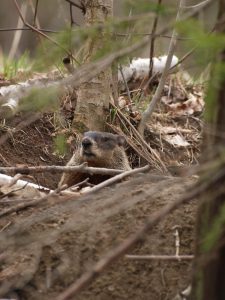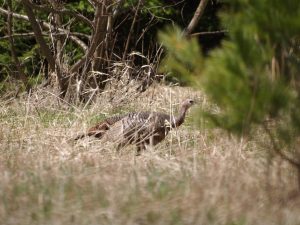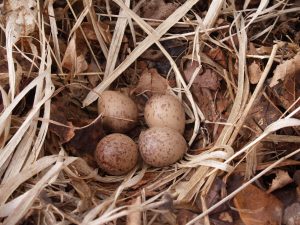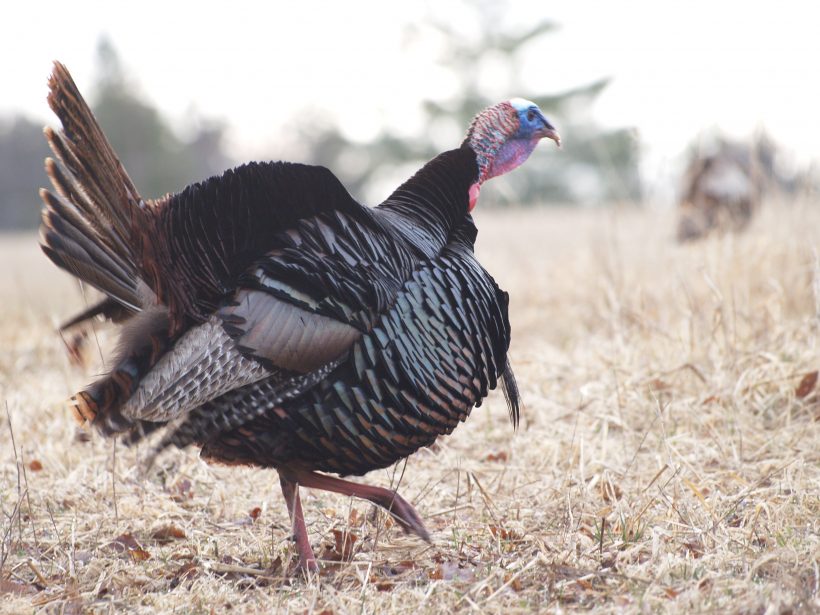WHAT IS THE VALUE OF A TURKEY GUIDE?
Would you believe the first bird? No golden haired hunter, I can’t brag that I bagged my first turkey on my first hunt. In fact, on my first hunt I witnessed a brilliant blue-green meteorite entering the earth’s atmosphere in the blackness of 4 a.m. It turned out to be some astronauts returning from an outer space mission. I watched a coyote chasing a doe and found where the coyotes had killed three turkeys. My two hunting buddies each bagged a turkey. During my next hunt we failed to see a bird and during three solo hunts in 2007 I saw lots of turkey but failed to take a shot. I had done my homework, scouted the area, tracked the birds and their habits but couldn’t get them within range. A lone hunter wandering around the bush spooked one hunt and just as the birds were about to come within gun range on another a hawk flew over and the alarmed birds headed for cover.
When Adrian Hare called and said he had an opening I was, as Shakespeare might have said, “all ears.” The season was fast coming to a close and he had one day open. Was it mere coincidence that it was the ONLY day I could have gone? Would it take a teacher of English Literature to appreciate the symbolism that this would be my sixth turkey hunt in my 6th decade?
Hare is a professional turkey guide who first works in Florida before heading home to Angus,Ontario for the season opener in late April. He’s up and at it for 70 days. We met at the first Canadian Turkey Calling Championship in Maynooth, Ontario in 2005. He represents Quaker Boy Calls and Realtree camo. Hare has lost track of the number of grand slams to his credit. (SIDE BAR EXPLAINS slams) In April 1997, the National Wild Turkey Federation (NWTF) recognized Hare as the first Canadian to complete an official “Slam”. Since he began turkey hunting in 1989, not including his clients’ count, Hare has shot 105 turkeys during both spring and fall hunts throughout North America. In 2007, Hare’s clients had shot 14 birds in Ontario. In short, Hare is a proven turkey hunter and guide.
T Day – May 29th
By 4:45 a.m. we were on the road. Hare mainly hunts private land. “On public land I’ve called in other hunters,” he said. Beside the safety issue it ruins the hunt. In darkness, we parked overlooking a valley where flickering lights indicated an awakening workforce. “Try not to step on any sticks,” he cautioned. “That’ll warn the toms. Turkeys have a keen sense of sight and hearing. They’re so smart. If they could smell they’d be impossible to kill. Turkeys have a brain the size of a pea and the memory of an elephant.”
Crossing the first farmer field we surprised a healthy looking red fox that made a quick exit. Approaching a second field we heard our first “gobble.” Hare was pleased. He hadn’t hunted this land all season and was certain the birds would be present. Quietly I positioned myself, back to tree, while Hare set up his camera. He was making some instructional CDs to help turkey hunters. More gobbles. Hare called infrequently. He didn’t want to scare the birds off. Suddenly, another gobble. Surprisingly, there was lots of daylight and the toms were still in the trees. We didn’t hear them descend. Alarmingly, I heard a terrible crashing noise from Adrian’s direction. I dared not look. That would be just when a turkey would appear and catch my movement.
Suddenly I saw a head, then two. Toms, cautiously moving in our direction. “Do you see it?” Hare whispered. “Yes.” But I couldn’t see the birds through the scope. I was using Hare’s gun and was unaccustomed to the scope. “There it is!” But I still couldn’t see it. Adrian looked at me. My eye was too close to the scope. That’s when the toms spotted Adrian’s head movement. “Well, I’ve been spotted,” he said. “Game over, lets go.”
The terrible crashing noise? A ground hog had come nose to nose with Adrian before realizing that Adrian wasn’t part of the environment. The crashing resulted from the groundhog’s panicked escape. Adrian was relieved it didn’t attack.

LESSON
Familiarize yourself with your gun. Adrian gave me a few quick pointers, after the fact, but too late to cash in on these birds. The good news is that had I fired the scope would have hit my glasses and we would have been off to the Emergency ward for stitches. “Keep your eye at least 4 fingers from the scope,” he said.
At the next site Adrian was annoyed to find a cigarette wrap and discarded turkey form. Someone had not only trespassed but also littered. Walking through the dew soaked grass I could see the value of Hare’s calf high Russell Moccasin boots. Actually they are snake boots for his Florida hunts. “Now the rest of the hunt gets harder,” he explained, as we had lost the advantage of waiting for the turkeys to descend from their roost. Guides need lots of patience – for clients as well as birds.
As we sat, concealed, scanning for birds from a favoured ground blind, Adrian mentioned that we would be picking up a portable ground blind. He had positioned it near a well used turkey trail only to have the turkeys shy away from it. With little happening we gathered up the blind and headed back to the truck for a break.
How quickly we forget. As we ambled along we discussed the corn crop and white-tailed deer hunting, totally forgot about turkeys and almost stumbled into a strutting tom. Later Adrian said that he thought the strutting fan before us was the back end of a grazing doe. Simultaneously our conscious minds collectively kicked into turkey mode and alerted us – TOM STRUTTING!
Quickly ducking out of sight we dropped all unnecessary equipment and circled through an adjacent bush hoping to set up for a shot. Creeping, crawling we set up more than once, each time closer to the intended target. However, we could hear the hens talking and the odd gobble told us that they were heading away from us. Adrian tried a few soft calls just to let the birds know that another hen was in the vicinity. Too much calling could spook them. He hoped to attract the hens and their attendant gobbler. However they moved on.

Prescouting assists in helping to understand the lay of the land. Hare anticipated that the birds would head up a nearby hill into an old apple orchard. Stealthily retreating we made an end run and set up in the orchard. While I got ready, back to tree, Adrian trimmed some branches for a better view and shooting laneway. Then we waited. As Adrian pointed out prescouting also allows the hunter the observe turkey travel patterns. There was no guarantee that we would intercept them from our set up but an educated guess is better than a random hope.
I breathed in the fragrance of the fresh apple blossoms and studied my territory in detail. As big as turkeys can be they do have a way of blending in. I wanted to consciously be aware of anything – such as a neck or head – that was out of place. Perhaps 30 minutes passed before we saw a couple of hens.
“Here comes the tom,” Hare whispered. “I can see his fan.” But the tom ducked downhill, out of sight. “Shift to your right,” he suggested so I could look down an alternate shooting laneway where the tom might reappear.
In the meanwhile, the hens had continued grazing on their way and past our site. Hare called softly, yelping with only a few notes, again letting the birds know that there was another hen nearby. Whether this caused the hens to hold up or not isn’t clear but with their hesitation the tom returned to my first shooting laneway. “There he is; do you see him?” Hare almost pleaded.
“Oh Barney, there he is. Can’t you see him?”
Although we were almost shoulder to shoulder I couldn’t see the tom because a tree blocked my view. I couldn’t see the tom and Adrian was almost beside himself in agony. Then, suddenly, I saw something. At first it was just a black object. Then, under an apple blossomed tree he raised his tail to show the unseen hen (us) that he was aware of her presence after which he lowered his head to graze.
“I see him,” I reassured Hare.
Adrian gave a couple of fast sharp clucks, the tom raised his head to look about for the source and I put the cross hairs of the scope on the bird’s head. Breathing in slowly and calmly counting silently in my head – “one thousand and one, one thousand and two” – all the while focusing, gently squeezing and BOOM.
“You got him!” yelled Hare as he burst from our blind like an Olympic sprinter in pursuit of gold. Much earlier, Hare had explained that I should aim at the turkey’s waddles if the bird is within 25 yards; at the head if 40 yards, for the shot will rise after 25 and then descend. (Lesson – Hare knows this because he patterns his shot before the hunt so he can predict its performance.) My one shot had taken this tom in the waddles, just as Hare had predicted.
“That bird was 49 paces; further than I thought,” he exclaimed.
Had I been using my own gun that tom would still be wandering the woodlands. Hare has customized his .20 gauge Bennelli modifying the cone and adding a crafted after market choke plus a Tasco scope . He patterns the Hevi-shot #6 so he knows exactly how it will perform. And so when Adrian said “you can shoot” my confidence was such in my turkey guide that I wasn’t even breathing hard. Unlike an earlier hunt, my heart wasn’t pounding in my ears. I was so calm. That I owe to confidence in my guide.
“Patience played a good roll in this hunt as we had to wait out the birds more than once,” said Hare. To which I add persistence. Knowledge is another ingredient but it is the use of that knowledge, a.k.a. wisdom, that truly will harvest your turkey.
SIDE BARS
SLAMS
There are 5 types of turkey slams recorded by the National Wild Turkey Federation (NWTF): the Grand Slam, Royal Slam, World Slam, Mexican Slam and the Canadian Slam. You need not complete a slam in a single calendar year. The term “slam” comes from baseball. Or so it is thought. Just how that happened or why is not evident. In baseball, of course, when the bases are loaded and the batter hits a home run, it is called a grand slam – 4 runs scored. And so the turkey grand slam counts for 4 different subspecies of turkey: the Eastern, Rio Grande, Merriam’s, and Osceola (Florida). The understanding of slam as applied to the Royal, World…becomes less than clear as no longer is 4 the magic number. The Royal slam comprises 5 birds – the 4 subspecies listed for the Grand plus the Gould’s. The World Slam has 6 birds including those of the Royal plus the Ocellated. Then there are two new slams as of January 2007. The Mexican slam consists of 3 birds (Rio Grande, Gould’s and Ocellated) and the Canadian slam which lists two birds, the Eastern and Merriam’s, which are found in Ontario, Quebec, Manitoba, Alberta and British Columbia. As you can see slams require a lot of travelling. For more information about slams, turkey records…goto www.nwtf.org.
Clothing tip- Beware noisy clothing that may attract the attention of keen eared turkeys. The “swish, swish” sound can be very alarming. Also, match colour with surroundings changing from tans early in the season to greens as the season progresses.

Ground Blinds- Although Adrian Hare’s experience was negative; Tom Doyle (former OOD archery columnist) told me that he had some hen turkeys actually stick their heads through one of the windows in his ground blind. “They were very curious,” he said. “I couldn’t move as the strutting tom was standing in the background taking it all in.”
Hare asked me if I knew what the term “Pro” meant. I responded – “professional”. Not so, he replied. In fact, it means “promotional” as in promoting a product for sale. F.Y.I.
ABOUT REPELLENTS
With tick and mosquito-borne illness season before us it pays to know something about the repellant you are purchasing to ward off these villains that carry Lyme disease, West Nile Virus or perhaps Tripe E (Eastern Equine Encephalitis). Some products must be applied and others clear an area – such as my ThermaCell that clears black flies and mosquitoes from my fly zone.
You’ll probably need a magnifying glass to read the ingredients on any product that you are considering.
Allethrin – a synthetic analog of a natural insecticide found in the chrysanthemum flower; odour-free. An area repellant, it is dispersed into the air and is apparently up to 93% effective fighting mosquitoes, black flies and no-see-ums. (Note- A breeze will render it ineffective.)
Permethrin – cousin to Allethrin, recommended for use on clothing, shoes, bed nets, and camping gear. Permethrin-treated clothing repels and kills ticks, mosquitoes and other arthropods retaining its effectiveness after repeated laundering. Not to be applied to your skin. Not available in Canada. One supplier that I called a few years ago had been raided by a government agency and all of this stock confiscated. But, you can purchase small amounts in the US and legally bring it home.
DEET – Has had its up and downs in the press over the years. IF used as per directions it has been declared safe by the Center for Disease Control (CDC) and the Environmental Protection Agency (EPA) in the US. Can’t speak for Canada. Don’t put on hands because hands have away of getting in mouths and eyes. In high concentrations may be harmful to kids and perhaps even self.
Not familiar with Picaridin which forms a barrier on your skin that blocks an insect’s ability to locate humans. Apparently, it provides protection equal to or longer than DEET.
Oil of Lemon Eucalyptus is plant-based and when tested against mosquitoes in the US provided protection similar to repellants with low DEET concentrations.
Years ago, when hunting with turkey guide Adrian Hare, we were silently watching an approaching flock of turkey from a mosquito infested swamp. Suddenly the flying blood suckers disappeared. Then I saw Adrian’s ThermaCELL unit. After that I obtained my own. I really don’t like to put any repellant on my skin unless absolutely necessary.
While on the topic, some hunters have suggested using their ThermaCELL pads as scent strips in deer season. Keith Lavon of ThermaCELL doesn’t recommend reusing the pads for any purpose. “We do manufacture a product called ThermaSCENT which provides fresh pads for the dispersal of scent using the ThermaCELL appliance. “In addition to the blank pads, we also use a platform raised above the (unit’s) grill for maximum effectiveness.”

AND FINALLY…
“One of the privileges of old age is to relate experiences that nobody will believe and give advice that nobody will follow.” Observant Anon
